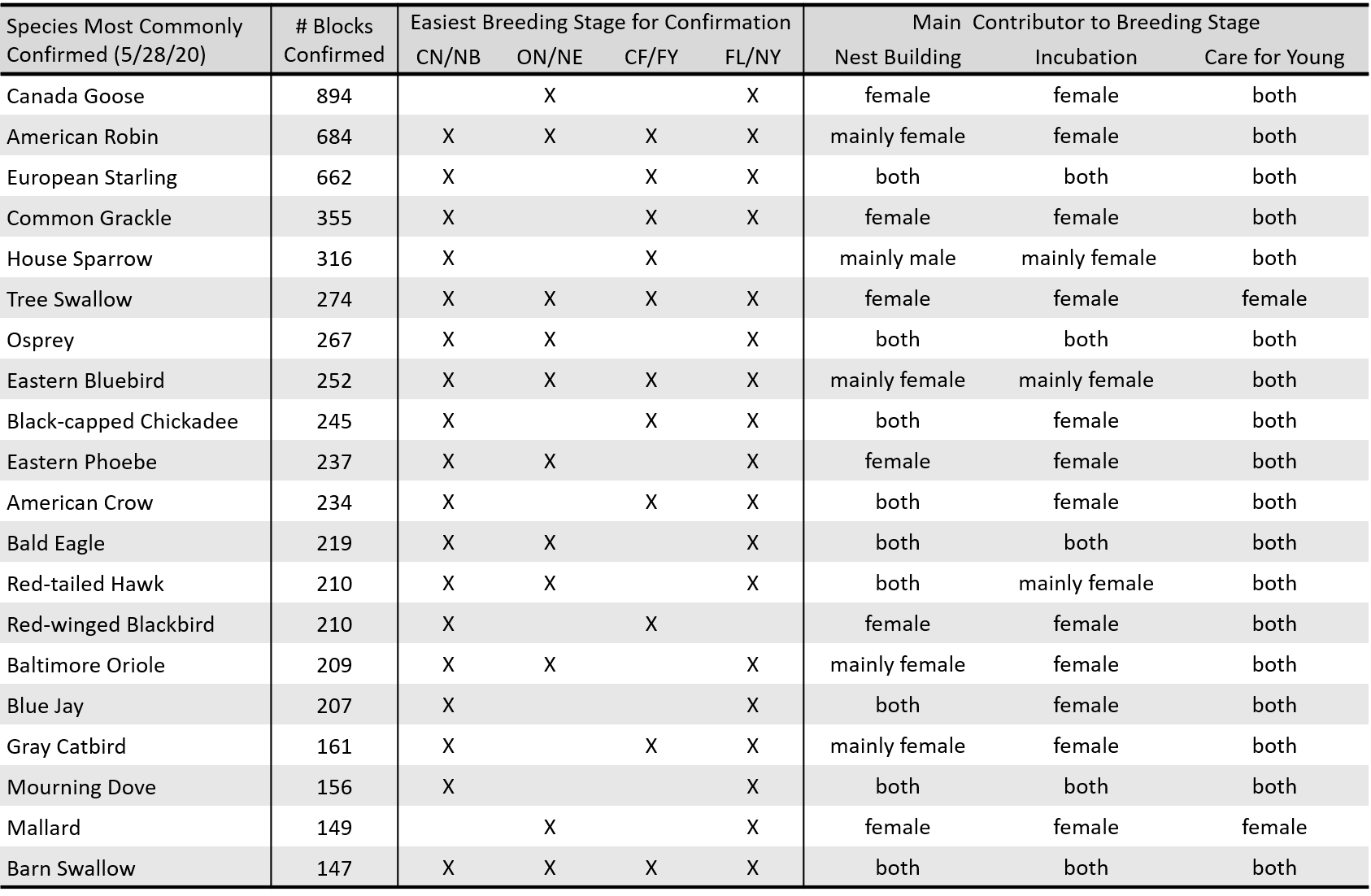Now that most birds are back on their breeding territories, you may find yourself struggling to figure out all this confirmation business. How does one go about confirming breeding? It might seem like it should just happen with spending time outside, after all, you’ve probably encountered breeding birds in the past. But how do you become more proficient?
Atlasing is birding with the intent to find breeding behaviors. Instead of focusing on increasing the number of species found in a block (which you’ve probably done by now), it’s now time to focus on behaviors. You want to try to catch birds “in the act,” specifically, in the act of building a nest or caring for young.
Here are some tips to help you get more breeding confirmations.
1. Start Easy
Don’t start off trying to confirm breeding for a Scarlet Tanager which breeds high up in the dense canopy of large tracts of forest. Try something easier, like waterfowl, or birds that breed in residential areas, like robins and phoebes. Here’s a chart of the top 20 most frequently confirmed species in the atlas so far. As you look for these common breeders, pay attention to posture, calls, and movement patterns. Once you have a feel for the “nesty” behaviors of these easier birds, you’ll be able to better recognize the same behaviors in other species. You may also want to refer to our post on Atlasing Around the Home for tips on some of the more suburban birds.

The 20 most frequently confirmed species as of May 28, 2020. These species are a good place to start if you are new to atlasing. Many of them are visible species that are easier to confirm nesting. Gain experience with these species and then move on to more challenging ones using the tips provided.
2. Slow Down, Linger
Take an hour to walk a mile. Seriously. It may seem ridiculously slow, but that’s not the point. Your focus should be on finding nesting birds, not racking up your species list. Going slow allows you to hear the small chips notes a pair uses to communicate with each other while collecting nesting material or food. The birds are also more likely to behave naturally and you, in turn, are more likely to see them and what they are up to before they are disturbed by your presence. When you do spot a bird, linger. Stay on it for 30 seconds or a minute to see if it is focused on foraging for itself or something else. If it’s foraging and eating the food right away, move on. If it is up to something else, stay on it and see if it’s collecting nesting material or food for young.
3. Be Quiet, Stay Still
This goes hand-in-hand with slowing down. The quieter you are, the more likely you are to detect the birds before you flush them, and they are more likely to keep going about their business. Being quiet also makes it easier to hear young nestlings giving their high-pitched begging calls. Sometimes it’s fruitful to just sit down on the ground or lean against a tree and sit quietly for 5 or 10 minutes. The birds will forget about your presence and go back to doing whatever they were doing before you arrived. Most of the time you will see at least some birds doing something related to breeding.
4. Focus On The Quiet Birds
Most of our normal birding focuses on identifying species, based mostly on what we hear singing. But singing males often just do that, they sing from a tall perch and defend their territory. That’s great and all, but it only gets you to possible or probable breeding. Some males don’t even help out in nest building, incubating, or raising young (that’s where point 5 comes in). In many species, you want to find the female and they are often quiet or only give soft chip notes. Use the singing birds to your advantage; look in the area nearby for a bird moving around quietly, which will often turn out to be the female busily taking care of nesting activities.
5. Learn Natural History
Use your birding experience to help you figure out what birds to be on the lookout for in different habitats. Then go one step further. Read up on the biology of species of interest. Find out where they build their nest, what type of nest it is, and what materials they use. Knowing this will help you know where to focus your attention when you are in the field. Then learn if the females or males do most of the nest building, incubating, or care for the young. Once you know that male Red-winged Blackbirds and Baltimore Orioles don’t help build the nest, you’ll know not to spend time watching them. On the other hand, when it’s fledgling time, you’ll be looking for male Northern Cardinals, Eastern Bluebirds, and Rose-breasted Grosbeaks feeding fledglings while the female starts incubating another brood. Use the table above as a jumping off point.
—
As you gain more atlasing experience, you’ll find that it becomes second nature. Enjoy the process and don’t get frustrated if it’s slow going at first. The second half of June is when things start to get really hopping, with all the young to be fed, fledglings hopping around with fluffy heads, and some birds starting second or even third broods. Take pleasure in each observation you make and have fun!



